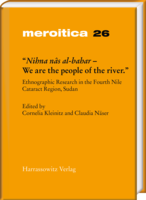|
weitere Titel zum Thema:
Download:
In 2008, a 170 km stretch of the Middle Nile valley was flooded by the reservoir of the newly constructed Merowe Dam at the Fourth Cataract. This large dam project led to the displacement of some 70,000 people, who lost their homeland, their way of life and much of their cultural heritage. Most of those affected were small-scale riverine farmers belonging to the Manasir and the Shaiqiyya of Amri and Hamdab. Although large-scale archaeological rescue campaigns were undertaken along the projected reservoir in anticipation of the flooding, the scientific community paid little attention to the living heritage of the present inhabitants of the Fourth Cataract region.
As a rare testimony to the affected people, the volume edited by Cornelia Kleinitz and Claudia Näser collects the work of ethnographers, social geographers, architects and archaeologists among local communities at the Fourth Cataract, and, in one case, in a prospective resettlement area. The contributions focus on traditional architecture, agricultural production and ways of life − including gender aspects − in this remote and highly specific cultural landscape before resettlement, investigate the process of forced resettlement and its consequences for the affected communities, and outline a political history and a critical ethnography of archaeological salvage in the context of dam building in the Middle Nile valley and the area of the Merowe Dam, respectively. Evaluating the conditions of dam construction, the salvage of cultural heritage and the fate of the affected people from several perspectives, the papers of this volume contribute to the critical discussion of the benefits and costs of major infrastructural development projects in Africa and beyond. |






